
Description: Optical luminescence is a water quality measurement technique commonly used to measure Dissolved Oxygen (DO). The technology is based on dynamic fluorescence quenching of a luminophore (luminescent dye molecule) by oxygen. A thin film of the luminophore is entrapped in an oxygen permeable polymer and undergoes excitation by absorption of photons being produced from an LED source. Upon relaxation (dissipation of excitation energy), light of lower energy i.e. longer wavelength, is emitted (luminescence). The measured magnitude of steady state luminescence (intensity) and/or average relaxation time (luminescence lifetime) is inversely proportional to the concentration of oxygen and thus, the signal to noise ratio of the measurement increases with decreasing DO concentration.
Costs USD Lower: $6,000
Costs USD Upper: $25,000
Accessories:
Advantages: Provides reliable real-time insitu measurements if properly maintained
Disadvantages: Frequent maintenance is required
Pictures:
